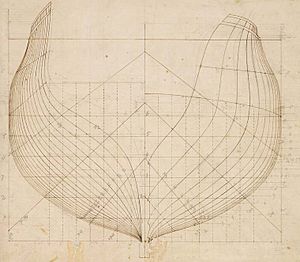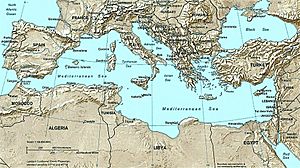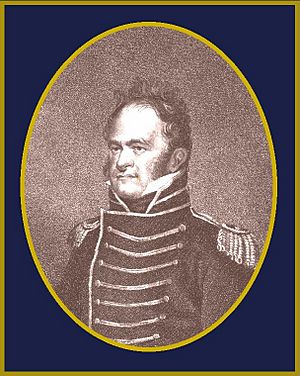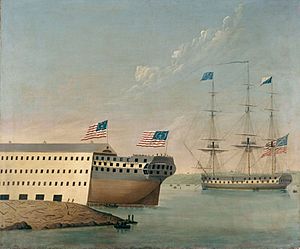USS Congress (1799) facts for kids

Congress by Charles Ware, 1816
|
|
Quick facts for kids History |
|
|---|---|
| Name | USS Congress |
| Namesake | Congress |
| Ordered | 27 March 1794 |
| Builder | James Hackett |
| Cost | $197,246 |
| Laid down | 1795 |
| Launched | 15 August 1799 |
| Maiden voyage | 6 January 1800 |
| Fate | Broken up, 1834 |
| General characteristics | |
| Type | 38-gun frigate |
| Displacement | 1,265 tons |
| Length | 164 ft (50 m) lpp |
| Beam | 41 ft (12 m) |
| Depth of hold | 13.0 ft (4.0 m) |
| Decks | Orlop, Berth, Gun, Spar |
| Propulsion | Sail |
| Complement | 340 officers and enlisted |
| Armament |
|
The USS Congress was a large, three-masted sailing ship called a heavy frigate. It was part of the early United States Navy. Built by James Hackett in New Hampshire, it was launched on August 15, 1799.
Congress was one of the first six frigates the U.S. Navy ever built. These ships were designed to be very strong and powerful. They were bigger and had more guns than most other frigates at the time. The ship was named "Congress" by President George Washington himself.
This ship had many important jobs. It helped protect American merchant ships during the Quasi War with France. It also fought against pirates in the First Barbary War. During the War of 1812, Congress captured many British merchant ships. Later, it helped stop piracy in the West Indies. It even became the first U.S. warship to visit China!
Contents
Building the USS Congress
The idea for the USS Congress came about because of pirates. In the late 1700s, pirates from places like Algiers were attacking American merchant ships in the Mediterranean Sea. They would capture ships and hold their crews for ransom. To stop this, the U.S. government decided to build warships.
The Naval Act of 1794 set aside money to build six frigates. However, there was a rule: if peace was made with Algiers, building the ships would stop.
A Special Design
Joshua Humphreys designed these new frigates, and his plan was quite unique. The ships were long, deep, and narrow. They also had very heavy guns. Humphreys made the hull (the body of the ship) extra strong. This design made the frigates tough enough to fight other frigates. But they were also fast enough to escape from much larger warships called "ships of the line."
President George Washington chose the name "Congress" for the ship. This honored the United States Congress, a key part of the U.S. government. The ship's construction started in 1795 in Kittery, Maine. James Hackett was in charge of building it.
Building was slow, and it even stopped completely in 1796 when a peace treaty was signed with Algiers. But then, problems with France started in 1798, leading to the Quasi-War. President John Adams asked for money to finish the ships, and work on Congress started again.
Its Guns and Weapons
The original plan was for 36-gun frigates. But Congress and its sister ship, Constellation, were so big that they were rated as 38-gun ships. Congress was about 164 feet long and 41 feet wide.
Warships back then didn't have a fixed set of guns. The cannons could be moved between ships. Each captain chose the weapons they wanted. They thought about how much cargo they had, how many crew members were aboard, and where they planned to sail. So, the guns on Congress changed often.
- For its first trip in 1799, Congress had 40 guns. These included 28 large 18-pounder cannons and 12 smaller 9-pounder cannons.
- During the War of 1812, it carried 44 guns. This time, it had 24 18-pounders and 20 even bigger 32-pounder cannons.
Early Missions
Congress was launched on August 15, 1799. Its first captain was James Sever. After getting ready in Rhode Island, it began its first voyage on January 6, 1800. It sailed with another ship, Essex, to protect merchant ships going to the East Indies.
A Stormy Start
Just six days later, a huge storm hit. All of Congress's masts broke and fell down! This happened because the ropes holding the masts were tightened in cold weather. When the ship reached warmer areas, the ropes loosened. Without proper support, the masts crashed down over four hours. One crew member died trying to fix the main mast.
The crew quickly set up emergency sails. The damaged ship slowly made its way back to the Gosport Navy Yard for repairs. Captain Sever was cleared of any blame, but many of his crew left for other ships.
After six months of repairs, Congress sailed again on July 26, 1800. It went to the West Indies to protect American merchant ships and look for French ships to capture. It had a few close calls, almost running aground twice in shallow waters.
A peace treaty with France was signed in February 1801. Congress returned to Boston in April. Many U.S. Navy ships, including Congress, were put "in ordinary." This meant they were taken out of active service and kept in reserve. As Congress sailed up the Potomac River, it passed Mount Vernon, George Washington's home. Captain Sever ordered the sails lowered and a 13-gun salute to honor the recently passed president.
Fighting Barbary Pirates
While the U.S. was busy with France, problems with the Barbary States (in North Africa) started again. The U.S. had been paying them "tribute" (money) to keep American ships safe. But in 1801, the ruler of Tripoli demanded more money.
President Thomas Jefferson sent a group of frigates to the Mediterranean Sea. Their job was to protect American ships and make peace. Congress joined this mission in 1804. It was captained by John Rodgers.
Congress helped blockade Tripoli and captured one enemy ship. Later, it carried the Tunisian ambassador back to Washington D.C. After this, it was again put "in ordinary" at the Washington Navy Yard. For a few years, it served as a classroom for young naval officers in training.
The War of 1812
In 1811, Congress needed major repairs before it could return to service. Captain John Smith took command in July 1812. Soon after, the U.S. declared war on Britain. Congress joined a squadron of other U.S. Navy ships.
Chasing British Ships
The squadron quickly learned about a fleet of British merchant ships heading to Britain from Jamaica. Congress and the other ships chased them. They followed a trail of coconut shells and orange peels that the British ships had left behind! They sailed almost all the way to England but never found the main convoy. On their way back to Boston, Congress helped capture seven British merchant ships.
Congress went on a second mission with its sister ship, President. They sailed from Boston in October 1812. They chased a British warship, HMS Galatea, and Congress captured a merchant ship called Argo. The two U.S. frigates stayed together for a while but didn't find many other ships to capture. They returned to Boston in December.
In April 1813, Congress and President managed to slip past a British blockade in Boston. They went on their third mission. Congress then sailed alone, patrolling near the Cape Verde Islands and Brazil. It captured four small British merchant ships.
By late 1813, Congress needed more repairs. But the war was taking up many resources, and there weren't enough materials or people to fix the ship. So, Congress was put "in ordinary" again for the rest of the war.
Second Barbary War
After the War of 1812, Algiers started attacking American merchant ships again. In March 1815, the U.S. declared war on Algiers. Two American squadrons were quickly prepared.
Captain Charles Morris took command of Congress. It helped transport the U.S. Minister to Holland. Then, Congress sailed to the Mediterranean Sea. But by the time it arrived, a peace treaty had already been signed with Algiers.
Congress joined other U.S. Navy ships, including the large Independence. They sailed together to Algiers, Tripoli, and Tunis. This was a show of force, letting everyone know the U.S. Navy was strong. In December, Congress returned to Boston and was again taken out of active service.
Later Years and Final Days
In 1816, Congress was prepared for a trip to the Pacific Coast. The goal was to take control of Fort Astoria from the British. But these plans changed when a U.S. Navy ship crashed into a Spanish ship. So, Congress was sent to the Gulf of Mexico instead to protect American trade.
Congress patrolled the Gulf of Mexico through mid-1817. It then sailed to Haiti to help settle a dispute over a captured ship. After that, it went to Venezuela to observe their fight for independence from Spain.
Later, Congress carried U.S. diplomats to South America. These diplomats wanted to assure countries there that the U.S. would stay neutral in their conflicts with Spain. The ship departed in December 1817 and returned in July 1818.
In 1819, under Captain John D. Henley, Congress made history. It sailed to China, becoming the very first U.S. warship to visit that country! It returned to the U.S. in May 1821.
Soon after, pirates in the West Indies became a problem. In 1822, Congress became the flagship for Commodore James Biddle. It helped capture pirate ships and their crews.
In 1823, Congress made another trip to deliver U.S. Ministers to Spain and Argentina. The ship had to be specially modified to carry one Minister's wife and eleven children! Plus, all their household goods and furniture filled the ship's cargo area. After dropping off the Ministers, Congress returned to Norfolk in December.
After this, Congress served as a "receiving ship" for the next ten years. This meant it was used as a floating station where new sailors would report. It was moved between the Norfolk and Washington Navy Yards. In 1834, a survey found that the ship was too old and damaged to be repaired. So, the USS Congress was taken apart that same year.
Images for kids






